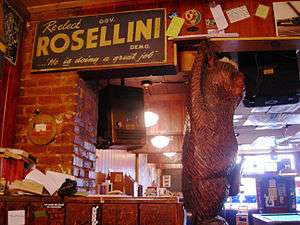Blue Moon Tavern
|
Main sign of the Blue Moon Tavern | |
| Private | |
| Industry | Food and beverage |
| Founded | Seattle, Washington, U.S. (April 1934) |
| Headquarters | Seattle, Washington, U.S. |
Area served | University District |


The Blue Moon is a tavern located on the west edge of the University District, Seattle, Washington, that has been visited by many counterculture icons over the years. It opened in April 1934, soon after the repeal of Prohibition in December 1933. It is the first and oldest tavern in the U-District. It was an instant hit with students (together with the still-thriving Duchess Tavern in Ravenna); under state law, students had to trek one mile from the campus to purchase drinks. The Blue Moon was one of the rare bars outside of the Central District to serve African American servicemen during World War II. The tavern also provided a haven for UW professors such as Joe Butterworth who were caught up in the McCarthyist purge.[1] It had further heyday in the 1950s and 1960s. Regulars included author Tom Robbins, poets Theodore Roethke, Richard Hugo, Carolyn Kizer, Stanley Kunitz, and David Wagoner, and painters Richard Gilkey and Leo Kenney. Visitors included Dylan Thomas, Ken Kesey, Allen Ginsberg and Mik Moore.
A popular story states that sometime in the late 1960s, Tom Robbins tried to call the artist Pablo Picasso in Barcelona from a pay phone at the Blue Moon Tavern. Supposedly, Robbins got through to Picasso, but the artist refused to accept the overseas collect calling charges.
The Blue Moon declined in the 1970s. Efforts to "redevelop" the property in 1989 were derailed by community activists led by Walt Crowley; however, an attempt in 1990 to gain landmark status failed. Developers spared the tavern after landmark status was denied. The Blue Moon remains one of the few surviving blue-collar landmarks in Seattle.[2][3]
The Blue Moon (1934), the Duchess (1934),[4] and the Knarr on The Ave (1935) are the oldest taverns in the University of Washington area.
In 1995, the alley to the west of the Blue Moon was named Roethke Mews in honor of the late poet.[5]
A tour of the Blue Moon by novelist James Knisely may be found at
See also
References
- ↑ Lange, Greg (1999-07-10). "University of Washington sees Red and fires three faculty members on January 22, 1949.". HistoryLink.org Essay 1482. Retrieved 2006-04-21.
Lange referenced “Bienz Sees Reds Strong at U.W.” The Spokesman-Review, (Spokane) March 25, 1948, Sec. 1, p. 1;
Wick, Nancy (December 1997). “Seeing Red”, Columns: The University of Washington Alumni Magazine, Vol. 17, No 4, pp. 16-21. - ↑ Brodeur, Nicole (2006-05-14). "City's blue-collar past slipping another notch". The Seattle Times. Retrieved 2006-05-21.
- ↑ Crowley, Walt (1999-04-01). "Blue Moon Tavern, An Unofficial Cultural Landmark". HistoryLink.org Essay 1001. Retrieved 2006-04-21.
Crowley referenced Walt Crowley (1992). Forever Blue Moon, The Story of Seattle's Most (In)Famous Tavern (Seattle: Blue Moon). - ↑ Higgins, Mark (1997-12-06). "Area is quintessential Seattle". "Neighbors: Ravenna". Seattle Post-Intelligencer. Retrieved 2006-04-21.
Updated at "From middle-class houses to mansions". Seattle Post-Intelligencer. n.d. Retrieved 2006-04-21. - ↑ Council Names Alley After Roethke
- Henry, Mary (2001-03-10). "Seattle Neighborhoods: Central Area -- Thumbnail History". HistoryLink.org Essay 3079. Retrieved 2006-04-21.
Henry referenced an extensive list of sources.
External links
- Blue Moon Tavern page at the Stan Iverson Memorial Archives
- Blue Moon Tavern Current calendar/links/impertinence
Coordinates: 47°39′41″N 122°19′12″W / 47.6615°N 122.32°W
